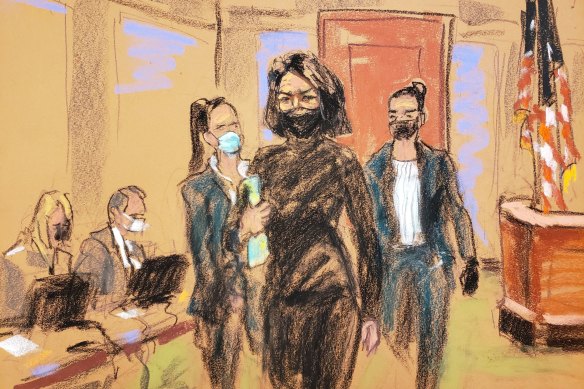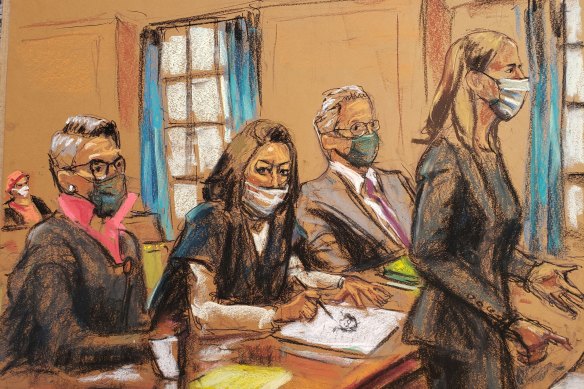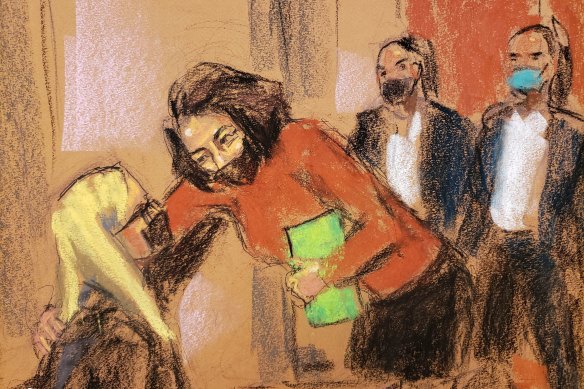This was published 10 months ago
‘A strange power move’: Ghislaine Maxwell’s odd in-court antics
Accused of sex-trafficking vulnerable young girls, Ghislaine Maxwell faced 80 years in prison. Yet during her five-week trial, she was often treated as more of a celebrity than criminal.
By Lucia Osborne-Crowley

Maxwell entered the New York courtroom most days dressed in an expensive jumper and tailored pants, escorted by two young female guards who appeared rapt by her jovial engagement with them.Credit: REUTERS
The first time I saw Ghislaine Maxwell in the flesh, on November 29, 2021, in Lower Manhattan’s Thurgood Marshall Courthouse on Foley Square, she was wearing a cashmere turtleneck, tailored black slacks and an incredibly calm, even relaxed, expression. She stood tall and elegant, defiant even, her trademark short, black pixie-cut now grown out to a tidy bob.
Her demeanour was surprising, given the circumstances. This day marked the beginning of a federal sex-trafficking trial in which she stood accused of helping the American financier Jeffrey Epstein orchestrate, over a period of years, a sexual-abuse ring targeting an unknown number of vulnerable, underage girls and young women. Epstein was found dead in a cell inside New York’s Metropolitan Correctional Centre on August 10, 2019, as he awaited trial for sex trafficking; now Maxwell, his long-time girlfriend, was facing 80 years in a federal prison. But you wouldn’t know it from looking at her.
I was one of only a handful of reporters allowed into the main courtroom of this criminal trial. I hadn’t known, when I moved from London to New York to cover it, just how closely I’d be able to observe this woman from my position in the press gallery, several feet behind the table at which she sat.
Every day, for the duration of her five-week trial, I studied this woman closely, a shadowy figure who had captured the public imagination the world over since the extent of her and Epstein’s activities had been exposed, primarily by Julie K. Brown, an investigative journalist at the Miami Herald, in a series of articles published in 2017.
Who was this woman who’d stood by Epstein’s side for at least a decade, helping to recruit and groom underage girls for him and his high-profile friends and who, as we’d hear during this trial, was sometimes even in the room when the abuse happened, often even engaging in it herself?
Entering the courtroom every day – always in tailored pants and an expensive jumper – Maxwell was escorted, as per custom, by two female, 20-something guards from the Metropolitan Correctional Centre across the road where she was being held. What wasn’t customary, however, was the friendly, even jovial rapport she seemed to be enjoying with them. She cracked jokes, they laughed. They appeared rapt as she chatted with them. This was a defendant who wasn’t being treated in the way you’d expect someone facing an 80-year sentence for aiding and abetting the sexual abuse of children to be treated.
Each morning, she met with a warm and, frankly, celebratory welcome from her lawyers, some of the most talented attorneys I’ve ever seen at work: lead defence attorney Bobbi Sternheim, Maxwell’s “fixer” Laura Menninger, former prosecutor Christian Everdell and Jeffrey Pagliuca. They stood to attention, giving her hugs and kisses and showering her with compliments on her outfit. Behind them, seated in the row in front of me, were her four older siblings: her brothers, Ian and Kevin, and her twin sisters, Isabel and Christine. She laughed and joked with them, too, which I knew wasn’t allowed. One day, one of the guards reluctantly stepped in to ask them to tone it down.
It was as if the terrible, traumatic events being recounted on the stand had little or nothing to do with her.
She behaved like the celebrity she was. She’d grown up the youngest of nine children to the disgraced media mogul, Robert Maxwell (who drowned after falling from his yacht, the Lady Ghislaine, near the Canary Islands in November 1991), which afforded her socialite status. She was rich and fabulous-looking, well-spoken and clever. Throughout the trial, she seemed calm, relaxed – even happy. In all my time as a court reporter, I’d never seen a defendant so well treated. There was a great deal of leniency on the part of the court, but she also exuded an impenetrable sense of having done nothing wrong.
Four accusers would give testimony: Jane, Carolyn, Anne Farmer and Kate, now in their late 30s or early 40s. At no point as they remembered harrowing events reaching back to the 1990s when they were young teenagers did Maxwell look up, even though each woman was on the stand for several hours. One of them (who didn’t want to be identified in relation to this) tried to catch Maxwell’s eye as she walked past her to enter the witness box; Maxwell appeared unmoved.
This was true even of Carolyn, the witness who could be most dangerous to her in terms of a potential prison sentence. [She’d been the most vulnerable of all the girls targeted. Introduced to Epstein and Maxwell by the older Virginia Giuffre – the girl in the infamous Prince Andrew photograph – she had made more than 100 visits to Epstein’s house in the early 2000s, when she was aged between 14 and 18. She lives with the long-term effects of complex trauma.]
This image of Maxwell – head bowed, eyes downcast – might make you think her demeanour was one of shame, so I want to be clear that it wasn’t. It looked more like disinterest, like she had somewhere else to be, something better to do. It was as if the terrible, traumatic events being recounted on the stand had little or nothing to do with her. Occasionally, she’d scribble something down on her legal pad.
Sometimes she did become actively involved in her own defence. This tended to happen when other witnesses – pilots, bank representatives, memory experts – were on the stand. Then she’d be gripped by a pressing need to write notes to her lawyers, possibly suggesting follow-up questions or giving commentary on what she considered to be the truth, or otherwise, of their statements. This was rare, though.
Perhaps one of the strangest – and, oddly, most intimate – experiences I had with Maxwell was a week or two into the trial, when I noticed a very unusual dynamic occurring between her and Jane Rosenberg, the courtroom sketch artist who was sitting next to me. Anyone who followed the news coverage of the trial would be familiar with Jane’s brilliant illustrations. She was a wonderful person to sit next to because she could tell remarkable stories about her decades-long career spent sketching some of the highest-profile defendants in recent history.

Maxwell, sitting between members of her legal team, makes a sketch of the court artist. Credit: REUTERS
One day, in a strange power move that left me frozen in my seat, Maxwell decided she would start drawing Jane while Jane was drawing her. (On this occasion, Maxwell’s siblings weren’t present and so Jane and I were sitting in the row of seats directly behind her. Maxwell had turned her chair around to face the back of the room, something she did often.) With just a couple of feet between them, the two women were staring at each other intensely, each looking between one another’s faces and their drawings, Jane’s a stunningly vivid rendering made using chalks and pencils on a large piece of cardboard, Maxwell’s on her green legal pad using a biro. “She’s drawing Jane,” I whispered to Will Pavia of the London Times, who was sitting on the other side of me.
With just a couple of feet between them, the two women were staring at each other intensely, each looking between one another’s faces and their drawings.
She must have heard me because, at that point, she turned to face me and started to draw me, too. Her gaze was strange and mesmerising. She has dark, piercing eyes and we held each other’s gaze for several minutes. When she was finished, she smiled and turned back to face the front of the courtroom, where the trial was continuing apace.
Another encounter with Maxwell that I’ll never forget occurred on December 27, 2021. Judge Alison Nathan, determined that the trial would finish before the end of the year, had given us a short break for Christmas. Maxwell’s birthday is on Christmas Day and she’d just celebrated her 60th birthday in a Manhattan jail cell before the court had reconvened.
In the press gallery, a handful of us waited patiently for everything to begin. Maxwell’s lawyers arrived and, soon after, the defendants’ door behind the judge’s bench opened and Maxwell appeared, flanked, as usual, by her friendly guards. She was wearing her customary oufit, but her energy was even more upbeat than usual, as was her reception. Her lawyers stood up and clapped, all of them simultaneously shouting, “Happy birthday, G!” as she walked towards them.

Maxwell embraces one of her lawyers as she enters the court.Credit: REUTERS
She smiled broadly – something I could only see from the crinkling of her eyes because we were in the middle of the Omicron outbreak and everyone was required to wear masks – and performed a sort-of curtsy, thanking everyone for their well wishes. When she arrived at the defence table, she kissed everyone on both cheeks, receiving long hugs as more recitations of “Happy birthday, G!” rang around the room. She looked at us at one point as if we might join in. As if we were at her cocktail party and not her criminal trial.
In late December, while the jury was out deliberating – it took them five full days to reach a verdict – I watched her pull her chair right up to the press seats and speak excitedly to a journalist from the American Broadcasting Company. They were careful not to be overheard but I and others thought we could make out the words “interview” and “television”. It seemed to us that she was so confident of being imminently acquitted that she was now setting up her exoneration interview. She continued to seem wholly unbothered by the brave, searing and convincing testimony of her victims and the evidence against her.
On December 30, just after 4pm, Maxwell walked into the courtroom as calmly as ever and Judge Nathan confirmed with the jury foreperson, an African-American woman in her 40s or 50s, that a unanimous verdict had been reached. Judge Nathan proceeded to read it out: Count one [Conspiracy to Entice Minors to Travel to Engage in Illegal Sex Acts]: guilty.
I looked at Maxwell, who was impassive as ever, her gaze fixed on the table in front of her.
Count two [Enticement of a Minor to Travel to Engage in Illegal Sex Acts]: not guilty.
Count three [Conspiracy to Transport Minors with Intent to Engage in Criminal Sexual Activity]: guilty.
And now came the last three counts on the indictment – the more serious “substantive” sex trafficking counts, as opposed to “conspiracy” counts, which attract heftier prison sentences.
Count four [Transportation of a Minor with Intent to Engage in Criminal Sexual Activity]: guilty.
Count five [Conspiracy to Sex Traffic a Minor]: guilty.
Count six [Sex Trafficking of a Minor]: guilty.
The room was airless and silent. Still, Maxwell barely moved. But then, when the formalities were over and she was allowed to leave, something changed. It was the first time I saw her enter or leave a room without treating her lawyers, family and sometimes us journalists with smiles, waves and pleasantries. Now, she looked at no one. She stormed out quickly. It was the first time I’d sensed any emotion from her.
In June 2022, Ghislaine Maxwell was sentenced to 20 years in prison for conspiring with Jeffrey Epstein to sexually abuse minors. She is serving her term in Florida’s FCI Tallahassee prison.
The Lasting Harm, by Lucia Osborne-Crowley (Allen & Unwin; $35), is out now.
To read more from Good Weekend magazine, visit our page at The Sydney Morning Herald, The Age and Brisbane Times.